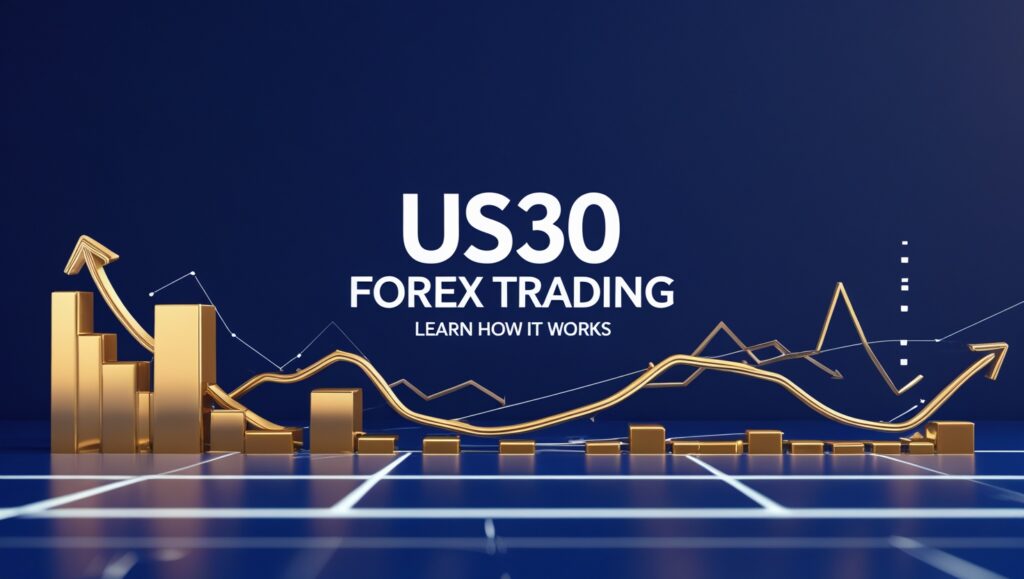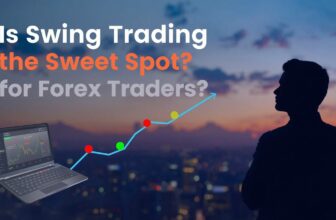
The US30, also known as the Dow Jones Industrial Average (DJIA), stands as one of the world’s most iconic financial benchmarks. As a Forex trader with over a decade of experience, I’ve seen firsthand how this powerful index offers unique opportunities in the currency markets.
“The US30 represents not just 30 companies, but the heartbeat of the American economy,” explains John Murphy, renowned technical analyst and author of Technical Analysis of the Financial Markets. “It’s a vital tool for both institutional and retail traders in the Forex market.”
In this comprehensive guide, I’ll walk you through:
- What US30 Forex is and why it’s a preferred choice among traders
- Step-by-step strategies for trading US30 effectively
- Advanced technical analysis techniques for spotting opportunities
- Essential risk management practices specific to US30 trading
- Real trading examples and expert insights
Whether you’re just starting your trading journey or looking to refine your US30 strategy, this guide combines theoretical knowledge with practical insights to help you navigate this dynamic market.
Before we dive deep into the strategies and techniques, let’s start with the fundamentals of what makes US30 Forex trading unique.
Key Takeaways
What You’ll Learn
- What is US30 in Forex: Understand how the Dow Jones Industrial Average (US30) works as a tradable Forex instrument
- Trading Framework: Master proven US30 trading strategies, from day trading to swing trading approaches
- Risk Management: Learn how to protect your capital with proper position sizing and stop-loss placement
Essential Knowledge
- Trading Hours: US30 Forex trades 24/5, with peak liquidity during NYSE hours (9:30 AM – 4:00 PM EST)
- Market Drivers: Key factors affecting US30 movement include Fed decisions, economic data, and company earnings
- Technical Tools: Most effective indicators for US30 analysis include Supply/Demand zones, Volume Profile, and Trend Analysis
Getting Started
- Start with a demo account to practice US30 trading without risking real capital
- Begin with smaller position sizes (0.1 lots) when transitioning to live trading
- Focus on mastering one strategy before diversifying your approach
💡 Pro Tip: “Success in US30 trading comes from understanding market structure and having strict risk management rules. Start small, stay consistent, and always protect your capital,” advises Peter L. Brandt, veteran trader and author of “Diary of a Professional Commodity Trader.”
Understanding US30 Forex Trading
What is US30 in Forex?
The US30, or Dow Jones Industrial Average (DJIA), represents 30 of America’s most influential publicly traded companies. In my experience as a trader, I’ve found that understanding its composition is crucial for successful trading.
“The US30 is unique because it’s price-weighted rather than market-cap weighted,” explains Jim O’Neill, former Chairman of Goldman Sachs Asset Management. “This means higher-priced stocks have a greater impact on the index’s movements.”
How US30 Forex Trading Works
When you trade US30 in the Forex market, you’re dealing with a Contract for Difference (CFD) that tracks the actual Dow Jones index. Here’s what makes it special:

Trading Mechanics
- Contract Size: 1 standard lot = $1 per point movement
- Minimum Trade Size: Usually 0.1 lots ($0.10 per point)
- Leverage Options: Typically ranging from 1:20 to 1:500 (varies by broker)
- Spread: Average 1-3 points during normal market conditions
US30 Trading Hours
I’ve found the most active trading periods to be:
Pre-Market: 4:00 AM - 9:30 AM EST
Main Session: 9:30 AM - 4:00 PM EST (NYSE Hours)
After-Hours: 4:00 PM - 8:00 PM ESTMarket Participants and Liquidity
Different types of traders influence US30 movements:
- Institutional Traders: Banks, hedge funds, pension funds
- Retail Traders: Individual traders like you and me
- Algorithmic Systems: High-frequency trading systems
Key Price Drivers
From my trading experience, these factors most frequently impact US30:
- Economic Data
- Non-Farm Payrolls
- GDP Reports
- Inflation Data
- Federal Reserve Actions
- Interest Rate Decisions
- Monetary Policy Statements
- FOMC Minutes
- Corporate Events
- Earnings Reports
- Mergers & Acquisitions
- Management Changes
Advantages of Trading US30 in Forex
- High Liquidity: Easy to enter and exit positions
- 24/5 Trading: More opportunities than traditional stock trading
- Lower Capital Requirements: Start with smaller accounts due to leverage
- Two-Way Trading: Profit potential in both rising and falling markets
Common Challenges
As Peter Brandt notes, “The biggest challenge in US30 trading isn’t finding opportunities – it’s managing risk effectively.” Common hurdles include:
- High volatility during news events
- Gap risk over weekends
- Managing leverage responsibly
- Emotional trading during volatile periods
Getting Started with US30
Before placing your first trade:
- Choose a regulated broker offering competitive US30 spreads
- Practice on a demo account for at least one month
- Start with smaller positions (0.1-0.2 lots)
- Focus on one trading session initially (preferably NYSE hours)
- Keep detailed trading records
💡 Pro Tip: “Focus on understanding market structure before expanding your position sizes. The best traders I know started small and scaled up gradually,” – Linda Raschke, professional trader and author.
Factors Affecting US30 Forex
Trading US30 has been a significant part of my journey in the forex markets, and I’ve learned that success comes from understanding the intricate web of factors that influence its movements. Let me share my insights and experiences about what really moves this market.
Economic Indicators and Market Movers
The US30’s reactions to economic data have always fascinated me. In my trading room, we often see sharp movements during major economic releases. I remember one particularly volatile session when the Non-Farm Payrolls came in significantly above expectations – the market moved over 300 points in mere minutes.
Here’s a breakdown of the most impactful economic indicators I track:
| Indicator Type | Impact Level | Typical Market Reaction |
|---|---|---|
| Non-Farm Payrolls | High | 100-300 point moves |
| Fed Rate Decisions | Very High | 200-500 point moves |
| GDP Data | Medium-High | 50-200 point moves |
| CPI Reports | High | 100-250 point moves |
“Market reactions to economic data are like fingerprints,” says Jim Rogers, renowned investor and author. “Each print is unique, but patterns emerge over time.” I couldn’t agree more with this observation.
Federal Reserve’s Influence
The Federal Reserve’s impact on US30 trading cannot be overstated. I’ve noticed that even subtle changes in Fed commentary can trigger significant market movements. During my last trading webinar, I demonstrated how the Fed’s forward guidance often creates multi-day trending moves in the US30.
The Fed’s influence typically manifests through three main channels:
- Interest Rate Decisions
I’ve observed that the market’s reaction often depends more on the accompanying statement than the actual rate decision. Last month, despite a widely expected rate hold, the US30 rallied 400 points when the Fed’s language turned slightly more dovish than anticipated. - Forward Guidance
The Fed’s outlook on future policy has become increasingly important in my trading decisions. I pay special attention to phrases like “data-dependent” or “maintaining restrictive policy,” as these often signal longer-term market trends. - Quantitative Policy Changes
These decisions typically create sustained trending moves that I look to trade. During the last QE program, I found success in buying pullbacks rather than trying to pick tops.
Corporate Performance and Market Psychology
Market psychology fascinates me, especially how it relates to corporate earnings season. I’ve developed a unique approach to trading during these periods. Instead of reacting to individual earnings reports, I look for patterns in sector performance.
Consider this recent example from my trading journal:
When major banks reported earnings last quarter, I noticed a pattern:
- Initial negative reactions were consistently followed by reversals
- Companies beating estimates saw delayed positive responses
- The broader market often ignored individual misses
This observation led me to modify my trading approach during earnings season. Now I wait for the initial volatility to settle before entering positions, which has significantly improved my success rate.
Global Events and Market Interconnectivity
Through years of US30 trading, I’ve learned that global events can create ripple effects that impact the index in unexpected ways. During the recent European banking concerns, I observed how US30 would often front-run European market movements, creating opportunities for early positioning.
The key global factors I monitor include:
Political Developments: These can create both risks and opportunities. During recent geopolitical tensions, I’ve noticed that US30 often acts as a safe-haven instrument, particularly during Asian trading hours.
Trade Relations: Having traded through various trade disputes, I’ve learned to watch for specific patterns:
- Initial headlines often cause overreactions
- Actual policy changes tend to have more muted impacts
- Market responses become more measured as situations develop
💡 Personal Trading Insight: “I’ve found that the best trades often come not from the events themselves, but from the market’s overreaction to them. Patience in these situations has been my most profitable strategy.”
Understanding these factors has helped me develop a more nuanced approach to US30 trading. Rather than reacting to each piece of news, I look for convergence of multiple factors before committing to larger positions. This approach has significantly improved my risk-adjusted returns over time.
Analyzing US30 Forex
As a professional trader focusing on US30, I’ve developed a comprehensive approach to market analysis that combines both technical and fundamental factors. Let me share my proven methodology for analyzing this dynamic market.
Technical Analysis Framework
When I analyze US30’s technical landscape, I focus on what I call the “Triple-Layer Analysis” approach. This framework has served me well over the years, especially during volatile market conditions.

Market Structure Analysis
I begin each trading day by examining the bigger picture. In my experience, understanding market structure is crucial for consistent profitability. Here’s my typical process:
“The first hour of trading often sets the tone for the entire session,” says Linda Bradford Raschke, and I’ve found this especially true for US30. I pay particular attention to:
- Opening Range: The first 30 minutes often define key support and resistance levels
- Pre-market High/Low: These levels frequently act as magnets during regular trading
- Previous Day’s Close: A critical reference point for market sentiment
Here’s how I categorize different market conditions I encounter:
| Market Type | Characteristics | Trading Approach |
|---|---|---|
| Trending | Clear direction, higher highs/lower lows | Trade with trend, buy dips/sell rallies |
| Ranging | Horizontal movement, defined boundaries | Trade range extremes |
| Volatile | Large swings, unclear direction | Reduce position size, wider stops |
| Breakout | Strong momentum, volume confirmation | Aggressive entries, trailing stops |
Price Action Signals
In my trading room, we focus heavily on price action. I’ve found that pure price movements often tell a clearer story than complex indicators. Some key patterns I look for:
Bullish Setups I Trade:
- Double bottoms with volume confirmation
- Bull flags after strong upward momentum
- Morning star patterns at support levels
Bearish Setups That Work For Me:
- Evening star formations at resistance
- Bear flags in downtrends
- Head and shoulders patterns with clear volume divergence
Volume Analysis and Market Depth
Understanding volume has transformed my trading approach. I pay particular attention to what I call “Volume Clusters” – areas where significant trading activity occurs. Here’s how I use this information:
- Volume Profile Analysis
During my morning preparation, I analyze the volume profile to identify:
- High-volume nodes (potential support/resistance)
- Low-volume areas (possible acceleration zones)
- Point of control (price level with maximum volume)
2. Real-Time Volume Interpretation
While actively trading, I watch for:
- Volume spikes at key levels
- Divergences between price and volume
- Unusual volume patterns during trend movements
💡 My Personal Trading Insight: “I’ve learned that volume confirmation is particularly crucial for US30 trades. When I see a price breakout without corresponding volume, I often stay patient and wait for better setups.”
Fundamental Integration
While technical analysis forms the backbone of my trading decisions, I always consider fundamental factors. Here’s how I integrate them:
High-Impact Events
During major news releases, I follow these guidelines:
Pre-Event:
- Reduce position sizes by 50%
- Widen stops by 20%
- Clear pending orders
Post-Event:
- Wait for 10-15 minutes
- Look for clear direction
- Enter with reduced riskPsychological Levels and Round Numbers
In my experience, psychological levels play a significant role in US30 movements. I pay special attention to:
- Round numbers (34,000, 35,000, etc.)
- Century marks within ranges (34,500, 34,600)
- Previous all-time highs/lows
Risk Management Integration
Every analysis I perform includes a risk management component. As Paul Tudor Jones wisely notes, and I strongly agree: “Risk control is the most important thing in trading.” Here’s how I implement this:
- Position sizing based on volatility
- Stop placement aligned with market structure
- Risk reduction during major events
- Regular reassessment of market conditions
Practical Application
Let me share a recent trading scenario from my journal: Last week, I identified a potential long setup when US30 was testing the 34,500 level. The setup matched my criteria:
- Strong technical support
- Positive market breadth
- Healthy volume confirmation
- Clear risk management levels
The trade resulted in a successful 200-point gain, primarily because I followed my analysis framework and maintained proper risk management throughout the position.
Remember, as I often tell my students: “Analysis without action is pointless, but action without analysis is dangerous.”
Trading Strategies for US30 Forex
Throughout my decade of trading US30, I’ve developed and refined various strategies that have consistently performed well across different market conditions. Today, I’ll share my most effective approaches and explain how I implement them in real market conditions.
Day Trading Strategies
Day trading US30 requires quick thinking and disciplined execution. I remember when I first started day trading – the fast-paced nature of US30 seemed overwhelming. Now, after years of experience, I’ve developed a structured approach that helps me maintain consistency.

My Core Day Trading Framework:
| Time Period | Strategy Focus | Risk Parameters |
|---|---|---|
| Pre-Market (4:00-9:30 EST) | Gap analysis, trend preparation | 0.5% risk per trade |
| Market Open (9:30-11:00 EST) | Momentum trading | 1% risk per trade |
| Mid-Day (11:00-14:00 EST) | Range trading | 0.75% risk per trade |
| Power Hour (14:00-16:00 EST) | Trend continuation | 1% risk per trade |
One of my most reliable day trading strategies is what I call the “Opening Range Breakout”. Here’s how I implement it:
- Setup Phase
- Mark the first 30-minute range
- Identify key support/resistance levels
- Check pre-market high and low
2. Execution Phase
I wait for one of these conditions:
- Clean break above the opening range
- Volume confirmation
- First pullback after the break
3. Management Phase
My standard approach includes:
- Initial stop below/above the breakout level
- Partial profit at 1:1 risk/reward
- Trail remainder using 15-minute lows/highs
💡 Personal Insight: “I’ve found that the first two hours of trading often offer the cleanest setups for day trading US30. The institutional order flow during this period creates more predictable price movements.”
Swing Trading Approach
Swing trading allows me to capture larger moves while maintaining a balanced lifestyle. My approach combines multiple timeframes with fundamental oversight.
Key Components of My Swing Trading Strategy:
The foundation of my swing trading success rests on three pillars:
Technical Alignment
I look for situations where multiple timeframes align:
- Daily trend direction
- 4-hour entry signals
- 1-hour confirmation
Fundamental Backdrop
Before entering any swing trade, I assess:
- Economic calendar events
- Fed speaker schedules
- Earnings calendar impact
Market Context
Understanding the bigger picture helps me size positions appropriately:
CopyBull Market Context:- Larger position sizes on longs
- Tighter stops on shorts
- Focus on buying dips
- Larger position sizes on shorts
- Tighter stops on longs
- Focus on selling rallies
Position Trading for Long-Term Trends
Through years of trading US30, I’ve learned that some of the biggest profits come from catching major trends. Here’s my methodology for position trading:
Entry Criteria:
- Weekly trend alignment
- Monthly support/resistance levels
- Volume profile confirmation
- Clear fundamental catalyst
I particularly focus on what I call “Triple Confirmation Points”:
- Technical Confirmation
- Trend line breaks
- Key level breaches
- Chart pattern completions
2. Fundamental Confirmation
- Economic data trends
- Policy shifts
- Sector rotation patterns
3. Sentiment Confirmation
- retail positioning
- institutional flow
- market breadth indicators
My Advanced Risk Management Framework
Risk management isn’t just about stop losses – it’s a comprehensive approach to capital preservation. Here’s how I structure my risk management:
Position Sizing Matrix:
| Market Condition | Maximum Risk Per Trade | Stop Loss Approach |
|---|---|---|
| Low Volatility | 2% account risk | Technical levels |
| Medium Volatility | 1.5% account risk | ATR-based stops |
| High Volatility | 1% account risk | Wide stops + small size |
“The goal isn’t to be right all the time,” as Paul Tudor Jones often says, “but to be right enough and manage your risk well enough to build consistency.” I’ve found this particularly true with US30 trading.
Strategy Adaptation
Markets evolve, and so should our strategies. I regularly review and adjust my trading approaches based on:
- Market condition changes
- Performance metrics
- Risk parameters
- New opportunities
💡 Final Trading Tip: “I’ve learned that the best strategy is one you can execute consistently. I started with simple setups and gradually added complexity as my experience grew. This measured approach has served me well in US30 trading.”
Remember, success in US30 trading comes from the combination of solid strategy, disciplined execution, and effective risk management. Start with one approach, master it, then gradually expand your trading arsenal.
Risk Management in US30 Forex Trading
The moment I first experienced a significant loss trading US30, I realized that successful trading isn’t about making the most money – it’s about managing risk effectively. Over years of trading this dynamic market, I’ve developed a comprehensive approach to risk management that has transformed my trading results.
The Foundation of Risk Management
Risk management in US30 trading isn’t just about setting stop losses; it’s about creating a complete framework for capital preservation. I learned this lesson the hard way during my early trading days when a single poorly managed position wiped out a month’s worth of profits.
Here’s how I structure my risk management framework for different market conditions:
| Market State | Risk Per Trade | Stop Loss Strategy | Position Management |
|---|---|---|---|
| Normal | 1% of capital | Technical levels | Scale out at 1:1, 2:1, 3:1 |
| Volatile | 0.5% of capital | 1.5x wider stops | Quick scale out, faster exits |
| Trending | 1.5% of capital | Trailing stops | Let winners run longer |
“The best traders aren’t defined by their winning percentage,” says Paul Tudor Jones, “but by their risk management.” This resonates deeply with my experience. I’ve found that consistent profitability comes from managing losses rather than chasing wins.
Position Sizing: The Core of Risk Control
Position sizing is where most traders go wrong with US30. I remember one particular trade where I ignored my position sizing rules during a volatile Fed announcement. That single mistake taught me more about risk management than months of successful trading.
My current approach to position sizing considers three key factors:
- Market Volatility
During normal market conditions, I use this basic formula for position sizing:
Position Size = (Account Risk × Account Balance) ÷ (Stop Loss in Points × Point Value)- Market Context
I adjust my standard position size based on:
- Current market volatility (VIX levels)
- Time of day (I reduce size during quiet periods)
- Upcoming high-impact news
3. Recent Performance
After a losing streak, I implement what I call the “recovery protocol”:
- Reduce standard position size by 50%
- Focus on higher probability setups
- Require stronger confirmation signals
Dynamic Stop Loss Management
Stop loss management is an art I’ve refined through thousands of trades. Rather than using a one-size-fits-all approach, I adapt my stop loss strategy to market conditions and trade context.
During trending markets, I use what I call the “trailing ladder” approach:
- Initial stop based on technical levels
- Move to break-even after 1:1 reward achieved
- Trail using recent swing points
- Tighten stops during momentum moves
💡 Personal Experience: “I once held onto a winning position too long because I didn’t have a clear exit strategy. Now, I plan my exits before entering any trade.”
Managing Open Positions
The real challenge in US30 trading isn’t entering positions – it’s managing them effectively. Through years of trading, I’ve developed a systematic approach to position management that helps remove emotion from the equation.
Consider this recent trading scenario:
I entered a long position on US30 after a clean breakout above resistance. Instead of hoping for the best, I immediately:
- Set a clear stop loss below the breakout level
- Defined three profit targets
- Established criteria for adding to the position
- Identified potential exit signals
This structured approach has dramatically improved my trading results.
Dealing with Drawdowns
Every trader faces drawdowns, but how you handle them determines your long-term success. Last year, I faced a challenging period where nothing seemed to work. Instead of giving up or doubling down, I:
- Reduced my position sizes by half
- Focused on my highest probability setups
- Increased my win rate requirements
- Conducted a thorough review of my strategy
This methodical approach helped me recover and emerge as a stronger trader.
Risk Management in Practice
Let me share a practical example from my trading journal:
During last month’s NFP release, I spotted a potential setup on US30. Despite the attractive entry point, I noticed elevated volatility and reduced my standard position size by 50%. This decision proved crucial when the market made an unexpected move against my position. Thanks to proper position sizing, what could have been a significant loss became a manageable drawdown.
“Risk management isn’t about avoiding risk,” as Ray Dalio often says, “it’s about managing risk.” This principle guides my everyday trading decisions, helping me stay in the game during challenging periods and thrive during favorable ones.
Remember, as I tell my mentees: Your best trading days often aren’t when you make the most money, but when you effectively manage risk in challenging market conditions.
Diversification and Portfolio Management in US30 Forex Trading
While US30 offers excellent trading opportunities, I’ve learned through experience that smart diversification can enhance returns while reducing risk. Let me share how I incorporate US30 Forex trading into a well-balanced trading portfolio.
The Power of Correlation Trading
Understanding market correlations has transformed my approach to US30 trading. When I first started, I focused solely on US30 movements. Now, I monitor related markets to gain a broader perspective and identify higher-probability trades.
Here’s how different markets typically correlate with US30:
| Market | Correlation | Trading Implication |
|---|---|---|
| S&P 500 | Strong Positive | Confirmation signals |
| NASDAQ | Strong Positive | Tech sector influence |
| US Dollar | Negative | Hedge opportunities |
| Gold | Varies | Safe-haven flows |
| VIX | Strong Negative | Risk sentiment indicator |
“Markets are interconnected in ways that aren’t always obvious,” notes Ray Dalio. I’ve found this particularly true when trading US30 alongside other instruments.
Time-Based Diversification
My experience has taught me that trading across different timeframes can significantly improve risk-adjusted returns. Here’s how I structure my time-based approach:
Intraday Trading (40% of Capital)
I focus on short-term opportunities during New York trading hours, when:
- Market liquidity is highest
- Price action is cleanest
- Volume provides reliable signals
Swing Trading (40% of Capital)
These positions typically last 2-5 days, allowing me to:
- Capture larger market moves
- Reduce trading frequency
- Lower transaction costs
Position Trading (20% of Capital)
Long-term positions based on:
- Major technical trends
- Fundamental shifts
- Macro economic cycles
💡 Personal Insight: “I’ve found that combining different timeframes helps smooth out my equity curve. When short-term trading is challenging, longer-term positions often provide balance.”
Strategic Asset Allocation
Through years of trading, I’ve developed what I call the “Flexible Core” approach to portfolio management. Here’s how I implement it:
The Core (70% of Trading Capital):
- US30 Forex trading forms the foundation
- Focus on proven strategies
- Strict risk management rules
The Flexible Component (30% of Trading Capital):
- Correlated market opportunities
- Seasonal trading patterns
- Special situation trades
For example, during earnings season, I might adjust my allocation:
Regular Allocation:
- US30 Direct: 70%
- Related Markets: 20%
- Cash Buffer: 10%
Earnings Season Allocation:
- US30 Direct: 50%
- Earnings Plays: 30%
- Related Markets: 10%
- Cash Buffer: 10%Risk Distribution Strategy
One lesson I learned the hard way is the importance of proper risk distribution. Consider this recent example from my trading journal:
During a volatile week, I had multiple US30 positions open. When unexpected news hit the market, my exposure was too concentrated, leading to larger than planned drawdown. This experience led me to develop my current risk distribution framework:
Maximum Risk Allocation:
- Single Trade: 1% of capital
- Single Strategy: 3% of capital
- Daily Risk Limit: 4% of capital
- Weekly Risk Limit: 8% of capital
Market Condition Adaptation
Markets evolve, and so should our approach. I constantly adjust my strategy based on market conditions:
During Trending Markets:
- Increase trend-following exposure
- Extend holding periods
- Trail stops wider
During Ranging Markets:
- Focus on range-bound strategies
- Tighter stops
- Faster profit-taking
Building a Robust Portfolio
When advising new traders, I emphasize these key principles for portfolio construction:
- Start with a Single Focus
“I began my journey focusing solely on US30 day trading. Only after mastering one approach did I expand to other strategies and timeframes.” - Add Complementary Elements
“Gradually, I incorporated correlated markets and different timeframes, always testing new approaches with smaller positions first.” - Monitor and Adjust
“Regular performance review is crucial. I evaluate my portfolio mix monthly and make adjustments based on market conditions and strategy performance.”
Remember, as legendary trader Paul Tudor Jones says, and I’ve found this to be absolutely true: “Don’t focus on making money; focus on protecting what you have.” This principle guides all my portfolio management decisions.
Your trading portfolio should reflect your personal style, risk tolerance, and available time. Start simple, add complexity gradually, and always maintain strict risk management principles.
Conclusion: Your Path to US30 Trading Success
As we wrap up this comprehensive guide on what is US30 in Forex trading, I want to share some final thoughts from my years of experience in this market. Trading US30 offers unique opportunities, but success requires a balanced approach combining technical expertise, fundamental awareness, and solid risk management.
Throughout my trading journey, I’ve learned that the most successful US30 traders aren’t those who make the biggest profits on single trades, but those who consistently manage risk and adapt to changing market conditions. “The market is a great teacher,” as Paul Tudor Jones often says, “but the tuition can be expensive if you don’t follow the rules.”
Remember these key principles for your US30 trading journey:
- Start with proper education and practice extensively on a demo account
- Develop a trading plan that suits your lifestyle and risk tolerance
- Focus on risk management before profit targets
- Stay informed about economic events and market conditions
- Keep detailed trading records and regularly review your performance
As Mark Douglas, renowned trading psychologist, reminds us: “Success in trading comes from consistent application of a proven strategy.” In my experience with US30 trading, this couldn’t be more true.
Whether you’re just starting or looking to refine your existing approach, remember that becoming a successful US30 trader is a journey, not a destination. Focus on continuous learning, stay disciplined with your risk management, and always trade within your means.
Ready to start your US30 trading journey? Begin with a demo account, practice the strategies we’ve discussed, and gradually work your way toward live trading. Remember, my goal in sharing these insights is to help you avoid the mistakes I made and find your path to consistent trading success.

















